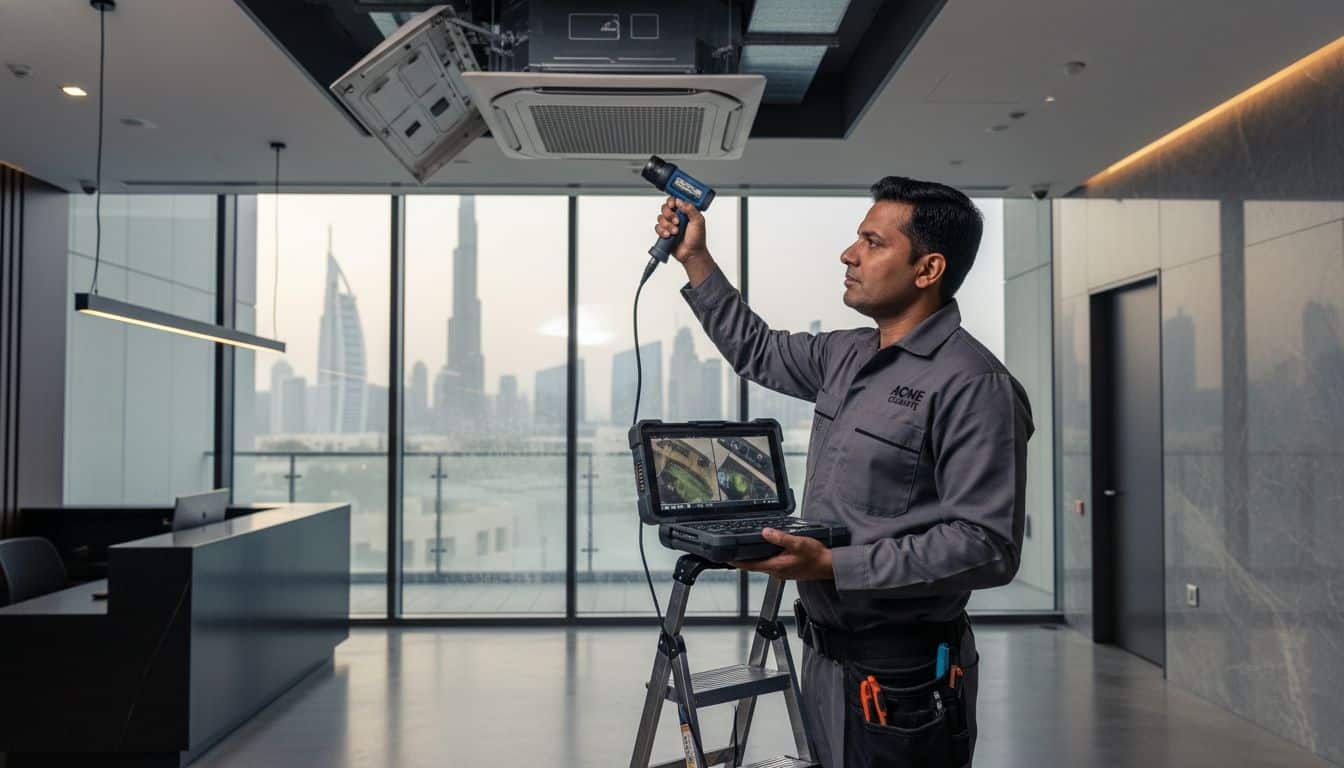
Complete Guide to Air Conditioning Contamination
Over 50 percent of indoor air quality issues can be traced back to contaminated air conditioning systems, according to experts. Property owners in Dubai know all too well how humidity and heat can turn any HVAC unit into a perfect breeding ground for bacteria, mold, and dust. Knowing exactly what lurks inside your AC system is not just about comfort. It is a critical step for protecting health, preventing costly repairs, and ensuring your building stays safe year-round.
Table of Contents
Contents
- 1 Table of Contents
- 2 Key Takeaways
- 3 Defining Air Conditioning Contamination
- 4 Types of Contaminants in AC Systems
- 5 Health Risks and Performance Impact
- 6 Sources and Causes of Contamination
- 7 Prevention, Cleaning, and Removal Solutions
- 8 Protect Your Indoor Air with Expert AC Cleaning from Saniservice
- 9 Frequently Asked Questions
- 10 Recommended
- Defining Air Conditioning Contamination
- Types of Contaminants in AC Systems
- Health Risks and Performance Impact
- Sources and Causes of Contamination
- Prevention, Cleaning, and Removal Solutions
Key Takeaways
| Point | Details |
|---|---|
| Contamination Causes | Air conditioning systems can become contaminated due to moisture accumulation, poor maintenance, and inadequate design, leading to microbial growth. |
| Health Risks | Contaminated HVAC systems can cause respiratory issues, sick building syndrome, and other serious health complications. |
| Preventative Maintenance | Regular professional inspections and maintenance are essential for mitigating contamination risks, especially in humid climates like Dubai. |
| Cleaning Solutions | Implementing advanced cleaning techniques and addressing contamination sources systematically is crucial for maintaining good indoor air quality. |
Defining Air Conditioning Contamination
Air conditioning contamination represents a complex environmental health challenge that occurs when harmful microorganisms, particulates, and chemical compounds accumulate within heating, ventilation, and air conditioning (HVAC) systems. According to EPA, these biological contaminants can include bacteria, viruses, dust mites, pollen, and other microscopic organisms that proliferate in poorly maintained air conditioning environments.
The contamination process typically begins with moisture accumulation, creating an ideal breeding ground for microbial growth. Lawrence Berkeley National Laboratory highlights that factors such as inadequate system maintenance, improper design, and consistent humidity can transform air conditioning systems into potential sources of indoor air quality degradation. These contaminated systems can then circulate harmful particles throughout residential and commercial spaces, posing significant health risks.
Key characteristics of air conditioning contamination include:
- Presence of biological pollutants like bacteria and mold
- Accumulation of dust and particulate matter
- Moisture buildup in system components
- Reduced air quality and potential respiratory hazards
- Potential spread of microorganisms through ventilation networks
For property owners and managers in Dubai, understanding these contamination dynamics is crucial. Air conditioning systems in hot, humid environments like the United Arab Emirates are particularly susceptible to rapid microbial growth, making regular professional cleaning and maintenance not just a recommendation, but a necessity for maintaining healthy indoor environments. HVAC Cleaning Process 2025 Guide provides comprehensive insights into preventing and addressing these critical contamination challenges.
Types of Contaminants in AC Systems
Air conditioning systems can harbor a complex ecosystem of potentially harmful contaminants that compromise indoor air quality and pose significant health risks. EPA identifies several critical categories of pollutants that can accumulate within HVAC systems, ranging from microscopic biological agents to chemical compounds that circulate through ventilation networks.
Biological Contaminants represent the most prevalent type of AC system contamination. These include microorganisms such as bacteria, viruses, mold spores, and fungal colonies that thrive in moisture-rich environments. According to EPA’s critical review, these biological agents can originate from multiple sources, including organic debris, dust accumulation, and intrinsic system components like cooling coils and drain pans.
The primary types of air conditioning contaminants can be categorized as follows:
- Microbial Contaminants
- Bacteria
- Mold and fungal spores
- Viruses
- Algae
- Particulate Matter
- Dust
- Pollen
- Hair and skin cells
- Insect debris
- Chemical Contaminants
- Volatile Organic Compounds (VOCs)
- Adhesive residues
- Lubricating oil emissions
- Cleaning chemical residuals
For property owners in Dubai, understanding these contaminant types is crucial. The hot, humid climate of the United Arab Emirates creates an ideal breeding ground for microbial growth, making professional AC maintenance not just recommended, but essential.
Air Conditioner Mold Removal Tips can provide additional insights into managing these complex indoor air quality challenges.
Health Risks and Performance Impact
Contaminated air conditioning systems pose significant health risks that extend far beyond simple equipment malfunction. Lawrence Berkeley National Laboratory reveals that compromised HVAC systems are directly linked to sick building syndrome (SBS), manifesting through a range of troubling symptoms including eye, nose, and throat irritation, persistent headaches, and chronic fatigue.
The potential health consequences of AC contamination are profound and multifaceted. CDC’s National Institute for Occupational Safety and Health highlights that prolonged exposure to contaminated air conditioning systems can trigger serious respiratory complications, including:
- Increased allergic reactions
- Respiratory infections
- Exacerbation of asthma symptoms
- Chronic inflammatory responses
- Compromised immune system functionality
Beyond direct health impacts, contaminated air conditioning systems experience substantial performance degradation. Accumulated biological and particulate matter dramatically reduces system efficiency, leading to:
- Higher energy consumption
- Reduced cooling capacity
- Increased mechanical wear
- Shortened equipment lifespan
- Inconsistent temperature regulation
For property owners and residents in Dubai’s challenging climate, understanding these risks is crucial. The region’s high humidity and temperature create an ideal environment for rapid microbial proliferation, making professional AC maintenance not just recommended, but essential for protecting both health and infrastructure. 7 Dangers of Unclean Air Conditioners provides additional insights into mitigating these critical indoor environmental challenges.
Sources and Causes of Contamination
Air conditioning systems are vulnerable to contamination through multiple intricate pathways that compromise indoor air quality. Office of Scientific and Technical Information reveals that HVAC contamination emerges from complex interactions between environmental conditions, system design, and maintenance practices.
Moisture Accumulation stands as the primary catalyst for contamination. When condensation builds up in air conditioning systems, it creates an ideal breeding ground for microbial growth. This process is particularly accelerated in humid environments like Dubai, where ambient moisture levels provide perfect conditions for rapid bacterial and fungal proliferation. Critical moisture-related contamination sources include:
- Blocked drainage systems
- Condensation within ductwork
- Stagnant water in drain pans
- Poorly insulated cooling coils
- High humidity environments
External and internal contaminant sources further complicate AC system integrity. These include:
- Outdoor Pollutant Infiltration
- Dust and particulate matter
- Pollen
- Industrial emissions
- Vehicle exhaust
- Internal System Contamination
- Accumulated organic debris
- Dead skin cells
- Fabric fibers
- Construction material residues
For property managers and homeowners in the United Arab Emirates, understanding these contamination dynamics is crucial. The region’s extreme temperatures and high humidity create a perfect storm for rapid microbial growth and system degradation. 9 Critical Health Risks of Dirty AC Ducts Abu Dhabi offers deeper insights into managing these complex indoor environmental challenges.
Prevention, Cleaning, and Removal Solutions
Addressing air conditioning contamination requires a comprehensive, systematic approach that combines proactive prevention and targeted intervention strategies. Florida State University’s Safety Manual emphasizes the critical importance of identifying contamination sources and implementing strategic corrective actions to maintain optimal indoor air quality.
Preventative Maintenance represents the first line of defense against AC system contamination. This proactive approach involves regular system inspections, comprehensive cleaning protocols, and strategic interventions designed to minimize microbial growth and pollutant accumulation. Key preventative strategies include:
- Routine professional HVAC system inspections
- Regular filter replacements
- Maintaining proper humidity levels
- Ensuring consistent drainage system functionality
- Implementing comprehensive air quality monitoring
Removal and cleaning solutions require a multi-step, scientifically validated approach:
- Comprehensive System Assessment
- Detailed contamination source identification
- Microbiological testing
- Thermal imaging of system components
- Airflow and efficiency diagnostics
- Advanced Cleaning Techniques
- High-pressure system sanitization
- Biocidal treatment of internal components
- HEPA filtration cleaning
- Moisture control interventions
For property owners and managers in Dubai’s challenging climate, understanding and implementing these solutions is crucial. The region’s extreme temperatures and high humidity demand specialized approaches to maintaining healthy indoor environments. Best Air Duct Cleaning Companies Near Me provides additional expert insights into navigating these complex indoor air quality challenges.
Protect Your Indoor Air with Expert AC Cleaning from Saniservice
Air conditioning contamination is a hidden threat that can harm your health and reduce your system’s performance. As the article reveals, moisture buildup and microbial growth inside your AC can lead to allergies, respiratory issues, and costly equipment damage. You deserve a solution that goes beyond surface cleaning to completely eliminate these contaminants and restore safe, fresh air to your home or workplace.
At Saniservice, we specialize in professional air conditioning cleaning and disinfection using scientific precision and evidence-based methods. Our NADCA-certified technicians meticulously clean every component to remove bacteria, mold, dust, and allergens. We operate with Swiss-quality standards and triple ISO certifications to deliver healthier air, improved energy efficiency, and longer lifespan for your system.
Discover the difference of a truly comprehensive AC cleaning by exploring our AC Cleaning & Maintenance – Saniservice AC Cleaning services and learn how we have transformed indoor environments in our Case Studies – Saniservice AC Cleaning. Don’t wait until contamination impacts your health or comfort. Visit us now at https://saniacservice.com to schedule your professional AC cleaning and breathe easier every day.
Frequently Asked Questions
What is air conditioning contamination?
Air conditioning contamination occurs when harmful microorganisms, particulates, and chemical compounds accumulate within HVAC systems, negatively impacting indoor air quality and health.
What types of contaminants are typically found in air conditioning systems?
Air conditioning systems can harbor biological contaminants (e.g., bacteria, mold, viruses), particulate matter (e.g., dust, pollen), and chemical contaminants (e.g., Volatile Organic Compounds, cleaning residues).
How can I prevent contamination in my air conditioning system?
Preventing contamination involves regular professional inspections, routine filter replacements, maintaining proper humidity, ensuring effective drainage, and monitoring air quality consistently.
What are the health risks associated with contaminated air conditioning systems?
Contaminated air conditioning systems can lead to health issues like allergic reactions, respiratory infections, asthma exacerbation, chronic fatigue, and compromised immune system functionality.
Recommended
- Best Air Duct Cleaning Companies Near Me – Expert Comparison 2025 – Saniservice AC Cleaning
- How to Get Rid of Mold in Air Conditioner Naturally – Saniservice AC Cleaning
- Air Conditioner Mold Removal Tips for a Healthier Home – Saniservice AC Cleaning
- HVAC Cleaning Process 2025: Step-By-Step Guide for Healthier Air – Saniservice AC Cleaning


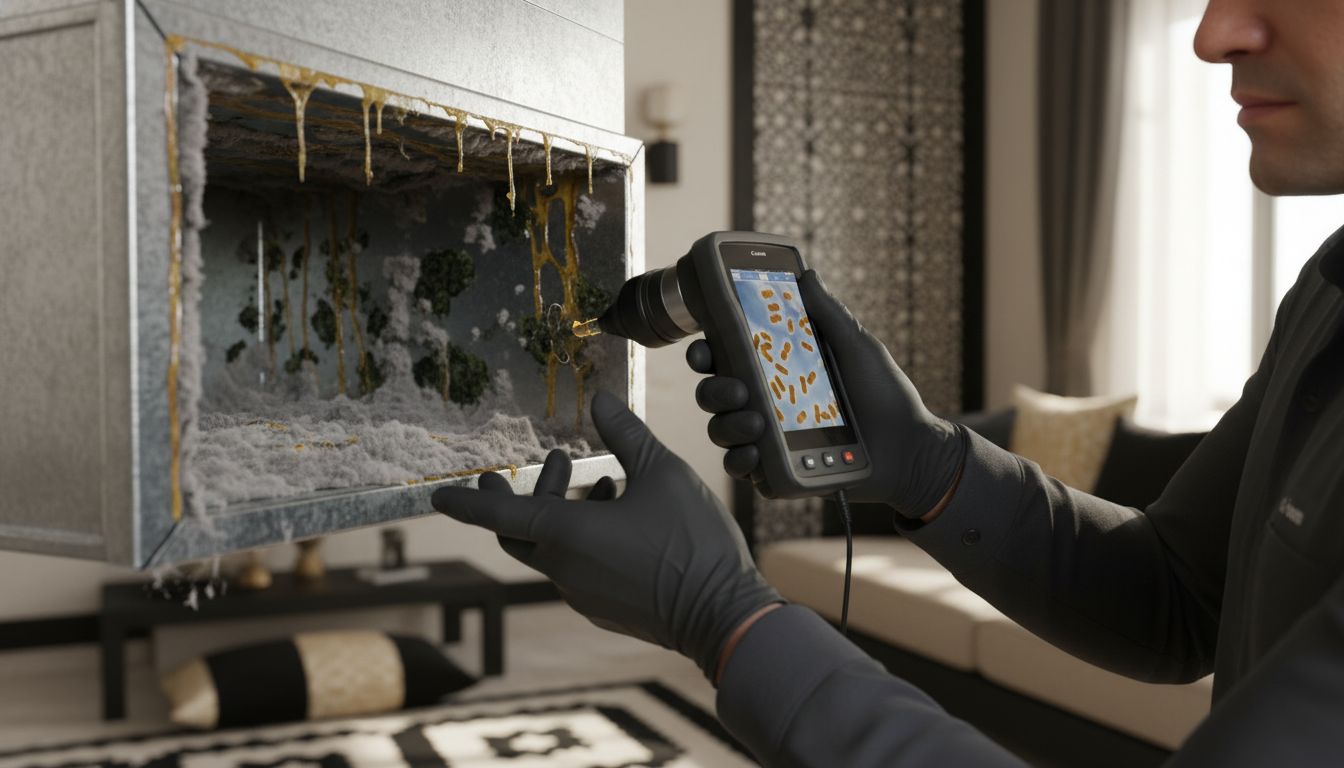
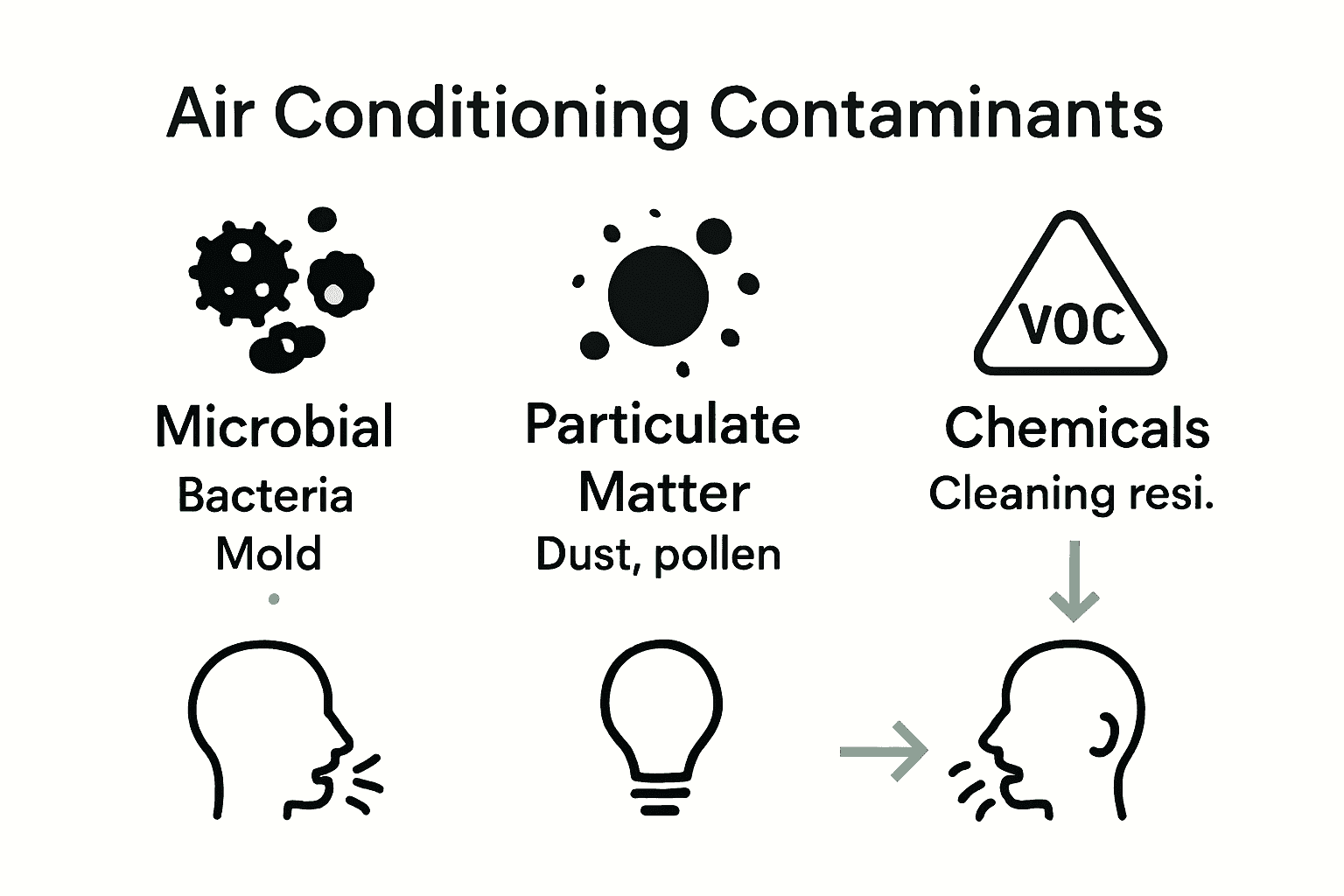
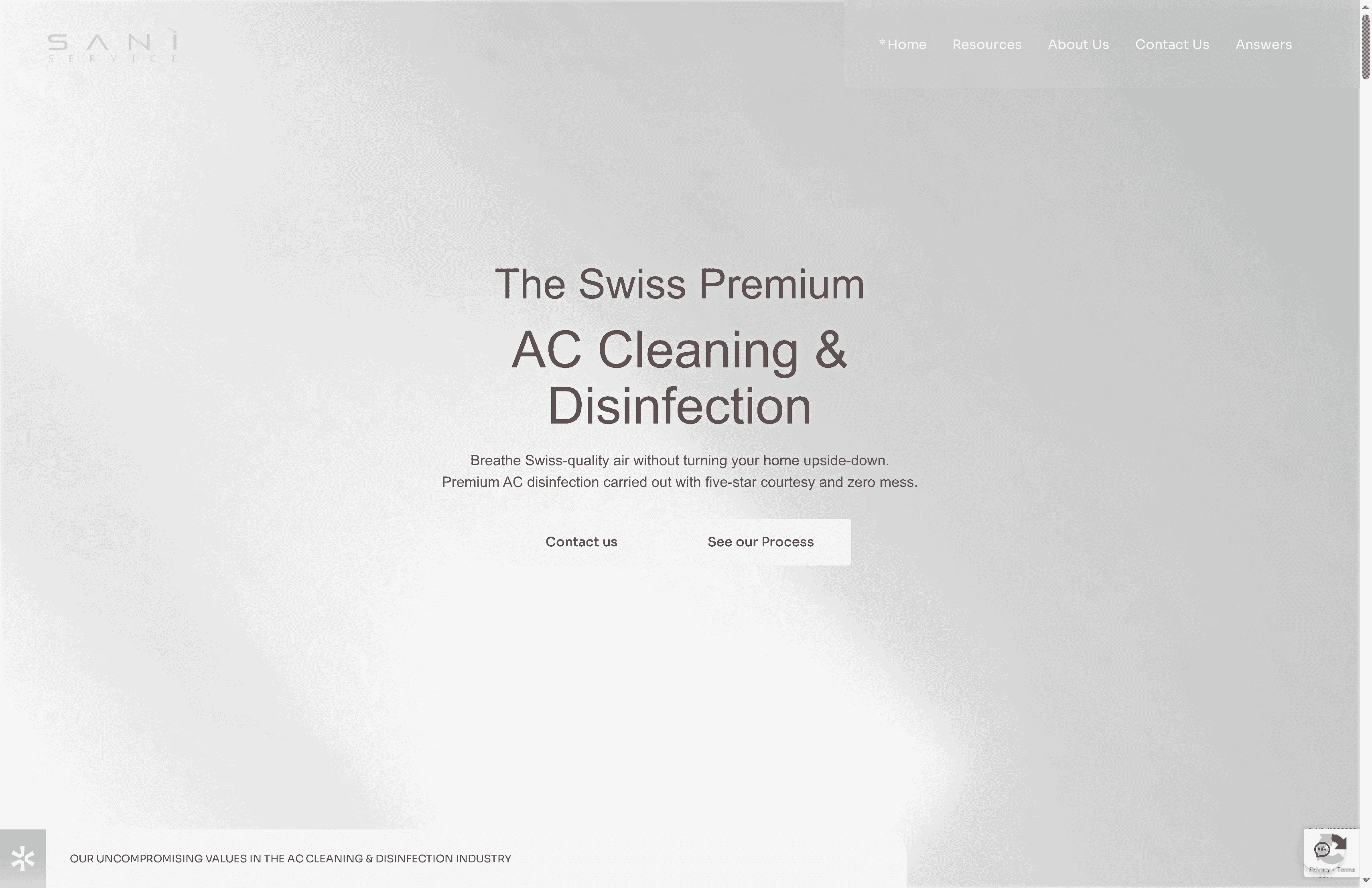
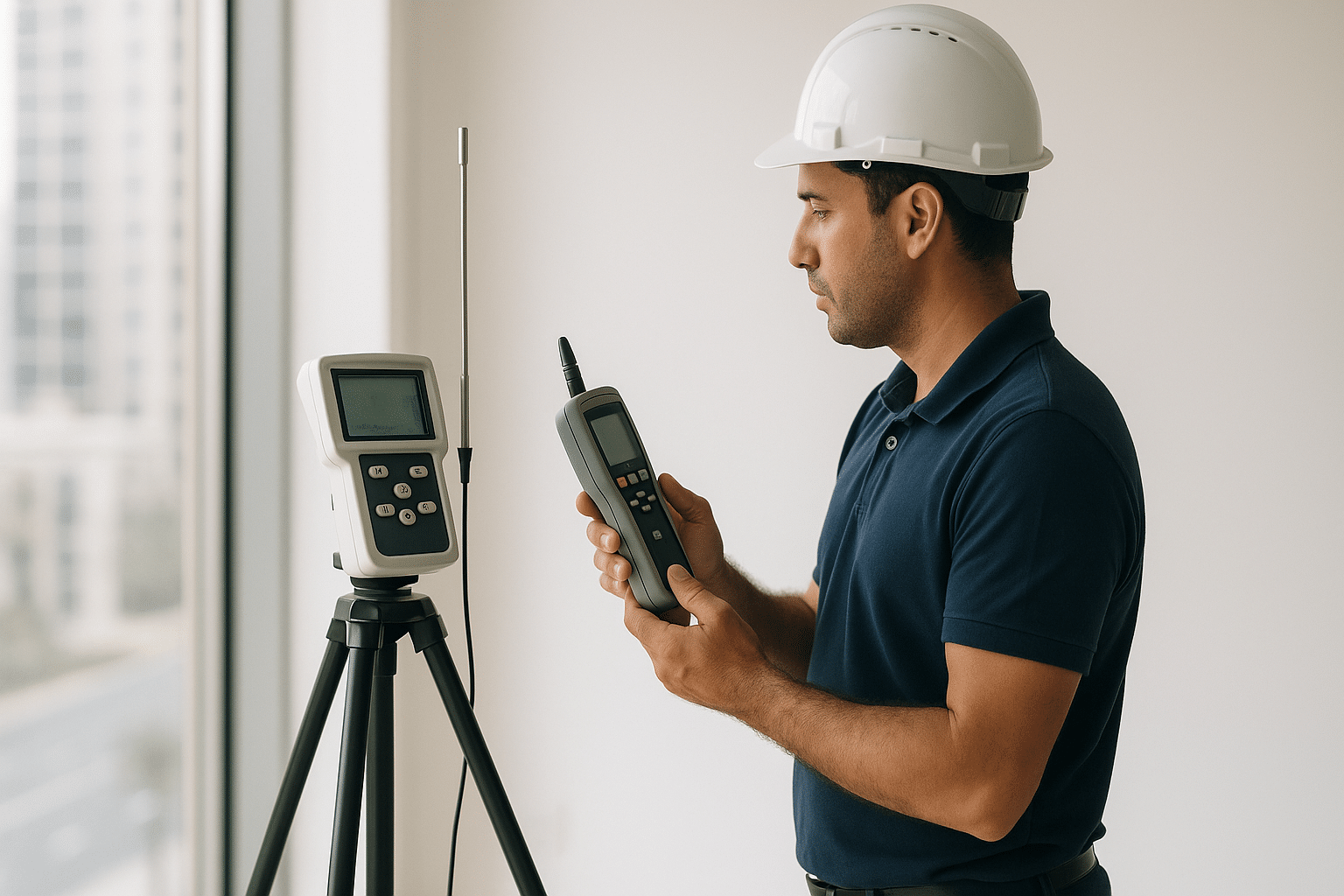

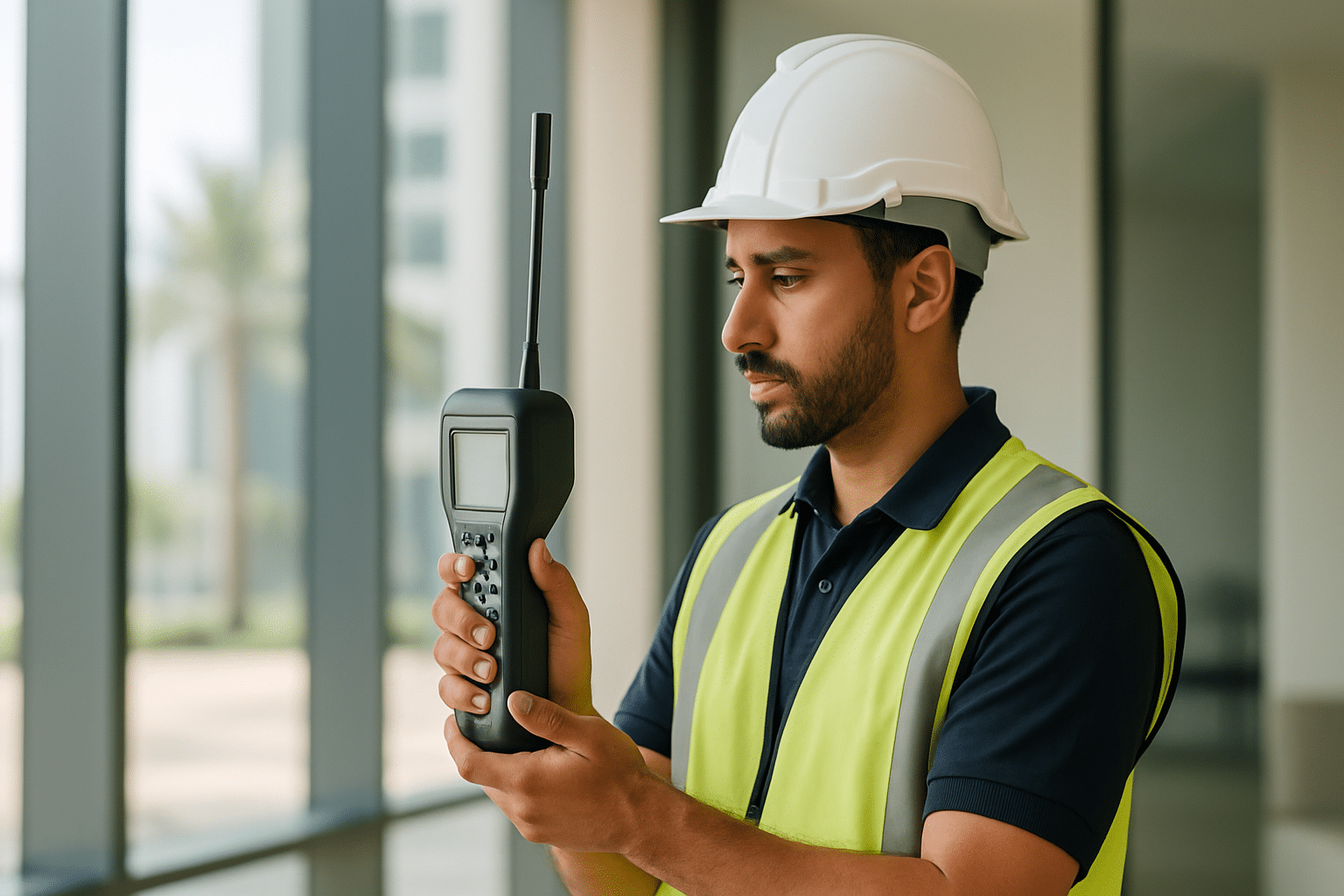

Leave a Reply